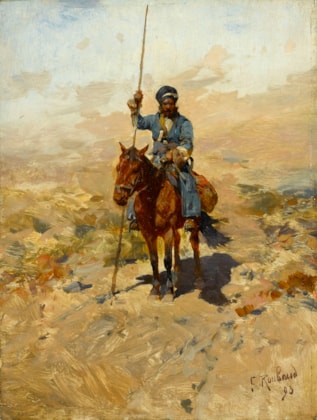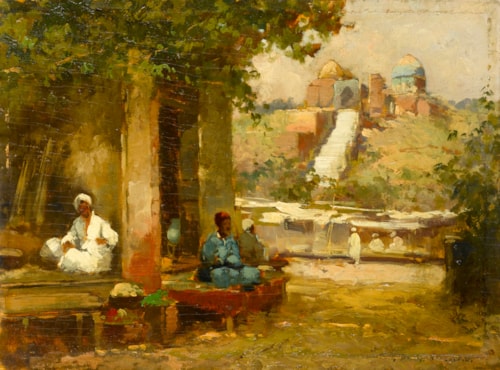onstantin Alexandrovich Trutovsky
(Kursk, Ukraine 1826 - Ukraine 1893)
City Travellers Being Offered Fruit at a Ukrainian Roadside Dwelling
signed and dated ‘1873’ (lower right)
oil on canvas
36 x 60 cm (14 x 23¾ in)
Every kind and class of rural society is represented in this portrait of Ukrainian life. Sitting under the ramshackle house to the right are two forlorn looking gypsy girls, the larger than life matriarch of the fruit selling family is standing, arm outstretched to give her sales patter to customers, while another man in a fur hat sits eating. The fruit stall is being eagerly looked over by two farm labourers and a child, meanwhile, the solid, bearded man is offering a melon to the cart of the local gentry, possibly on their way to a church in the distance.
This genre scene of rural Ukrainian life is typical of Konstantin Alexandrovich Trutovsky’s work. The delicate treatment of all subject matter with a high level of detail is particularly noticeable for its realism; the deteriorating chimney stack with its peeling sections, the fruit and the costumes of the various characters are all examples of this. Working in a realistic academic style, Trutovsky’s work concentrated on genre paintings depicting life in Kursk Gubernia and also in the Ukraine. His scenes focus on human interaction in the foreground and are generally set in a rural landscape with one or two buildings visible in the far distance. Trutovsky’s works were also known for being critical portraits of social and political issues.
Trutovsky was a Russian-Ukrainian Realist painter and graphic artist. In 1839 he entered the Principle Engineering School, where his fellow classmates included Feodor Mikhailovich Dostoevsky (1821-81). Trutovsky began his career as a military engineer in St. Petersburg, but he displayed artistic talent from an early age. Whilst working as an engineer he also attended the Imperial Academy of Arts between 1845 and 1849 and he became an Academician in 1861. It was during his time at the Academy that he created the earliest portrait of his class-mate Dostoevsky in 1847, and it remains the only known portrait of the writer in his younger years. Trutovsky also wrote Recollections About Dostoevsky (1893) which contains a description of the author’s appearance while he was at the engineering school. In 1871 Trutovsky was appointed an inspector of the Art College in Moscow, a post in which he was to remain for fourteen years.
Trutovsky is particularly well known for his numerous genre scenes on Ukrainian themes, many including peasants. He was interested in ethnography and depicted colourful Ukrainian folk customs, not shying away from ‘a dash of good humour’. Like Taras Shevchenko, Ukraine’s foremost bard, Trutovsky often described the miserable and hopeless life of the peasant, and the two shared many similar ideals in their work. Despite being primarily a poet Shevchenko was also an artist, and the influence of Ukrainian romanticism is evident in both of their art works. Folk art and folk literature appealed greatly to the pair and provided much inspiration to their works. Later in his life Trutovsky took part in publishing Lev Zhemchuzhnikov’s, Picturesque Ukraine, and illustrated the poems and biography of Shevchenko.
Every kind and class of rural society is represented in this portrait of Ukrainian life. Sitting under the ramshackle house to the right are two forlorn looking gypsy girls, the larger than life matriarch of the fruit selling family is standing, arm outstretched to give her sales patter to customers, while another man in a fur hat sits eating. The fruit stall is being eagerly looked over by two farm labourers and a child, meanwhile, the solid, bearded man is offering a melon to the cart of the local gentry, possibly on their way to a church in the distance.
This genre scene of rural Ukrainian life is typical of Konstantin Alexandrovich Trutovsky’s work. The delicate treatment of all subject matter with a high level of detail is particularly noticeable for its realism; the deteriorating chimney stack with its peeling sections, the fruit and the costumes of the various characters are all examples of this. Working in a realistic academic style, Trutovsky’s work concentrated on genre paintings depicting life in Kursk Gubernia and also in the Ukraine. His scenes focus on human interaction in the foreground and are generally set in a rural landscape with one or two buildings visible in the far distance. Trutovsky’s works were also known for being critical portraits of social and political issues.
Trutovsky was a Russian-Ukrainian Realist painter and graphic artist. In 1839 he entered the Principle Engineering School, where his fellow classmates included Feodor Mikhailovich Dostoevsky (1821-81). Trutovsky began his career as a military engineer in St. Petersburg, but he displayed artistic talent from an early age. Whilst working as an engineer he also attended the Imperial Academy of Arts between 1845 and 1849 and he became an Academician in 1861. It was during his time at the Academy that he created the earliest portrait of his class-mate Dostoevsky in 1847, and it remains the only known portrait of the writer in his younger years. Trutovsky also wrote Recollections About Dostoevsky (1893) which contains a description of the author’s appearance while he was at the engineering school. In 1871 Trutovsky was appointed an inspector of the Art College in Moscow, a post in which he was to remain for fourteen years.
Trutovsky is particularly well known for his numerous genre scenes on Ukrainian themes, many including peasants. He was interested in ethnography and depicted colourful Ukrainian folk customs, not shying away from ‘a dash of good humour’. Like Taras Shevchenko, Ukraine’s foremost bard, Trutovsky often described the miserable and hopeless life of the peasant, and the two shared many similar ideals in their work. Despite being primarily a poet Shevchenko was also an artist, and the influence of Ukrainian romanticism is evident in both of their art works. Folk art and folk literature appealed greatly to the pair and provided much inspiration to their works. Later in his life Trutovsky took part in publishing Lev Zhemchuzhnikov’s, Picturesque Ukraine, and illustrated the poems and biography of Shevchenko.





 contact
contact contact
contact +44 20 7313 8040
+44 20 7313 8040









